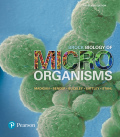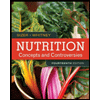
EBK BROCK BIOLOGY OF MICROORGANISMS
15th Edition
ISBN: 8220103633352
Author: Stahl
Publisher: PEARSON
expand_more
expand_more
format_list_bulleted
Question
Chapter 1.4, Problem 3MQ
Summary Introduction
Waste generated from different sources pose a potential threat to the environment and community. Waste materials are discarded after a primary use industry, household, and agriculture. These wastes contain hazardous substance that might pollute the environments such as municipal solid waste, sewage waste, radioactive waste, and hazardous waste. The environmental pollution causes serious diseases to all living beings. Microbes are also used to clean up the environmental wastes by bioremediation process.
Expert Solution & Answer
Want to see the full answer?
Check out a sample textbook solution
Students have asked these similar questions
Based on your results from the Mannitol Salt Agar (MSA) media, which of your bacteria were mannitol fermenters and which were not mannitol fermenters?
help tutor please
Q8. A researcher wants to study the effectiveness of a pill intended to reduce stomach heartburn in pregnant
women. The researcher chooses randomly 400 women to participate in this experiment for 9 months of their
pregnancy period. They all need to have the same diet. The researcher designs two groups of 200 participants:
One group take the real medication intended to reduce heartburn, while the other group take placebo
medication. In this study what are:
Independent variable:
Dependent variable:
Control variable:
Experimental group: "
Control group:
If the participants do not know who is consuming the real pills and who is consuming the sugar pills.
This study is
It happens that 40% of the participants do not find the treatment helpful and drop out after 6 months.
The researcher throws out the data from subjects that drop out. What type of bias is there in this study?
If the company who makes the medication funds this research, what type of bias might exist in this
research work?
Chapter 1 Solutions
EBK BROCK BIOLOGY OF MICROORGANISMS
Ch. 1.1 - In what ways are microorganisms important to...Ch. 1.1 - Why are microbial cells useful for understanding...Ch. 1.1 - What is a microbial colony and how is one formed?Ch. 1.1 - What are bacterial colonies and how are they...Ch. 1.2 - What structures are universal to all types of...Ch. 1.2 - Prob. 2MQCh. 1.2 - What structures can be used to distinguish between...Ch. 1.2 - Prob. 1CRCh. 1.3 - How old is Earth and when did cells first appear...Ch. 1.3 - Prob. 2MQ
Ch. 1.3 - Why were cyanobacteria so important in the...Ch. 1.3 - Prob. 1CRCh. 1.4 - Prob. 1MQCh. 1.4 - Prob. 2MQCh. 1.4 - Prob. 3MQCh. 1.4 - Prob. 1CRCh. 1.5 - Define the terms magnification and resolution.Ch. 1.5 - Prob. 2MQCh. 1.5 - Prob. 1CRCh. 1.6 - Prob. 1MQCh. 1.6 - Prob. 2MQCh. 1.6 - How can cells be made to fluoresce?Ch. 1.6 - Prob. 1CRCh. 1.7 - Prob. 1MQCh. 1.7 - Prob. 2MQCh. 1.7 - Prob. 1CRCh. 1.8 - Prob. 1MQCh. 1.8 - Prob. 2MQCh. 1.8 - Prob. 1CRCh. 1.9 - Prob. 1MQCh. 1.9 - Prob. 2MQCh. 1.9 - Besides ending the controversy over spontaneous...Ch. 1.9 - Explain the principle behind the Pasteur flask in...Ch. 1.10 - How do Kochs postulates ensure that cause and...Ch. 1.10 - What advantages do solid media offer for the...Ch. 1.10 - Prob. 3MQCh. 1.10 - Prob. 1CRCh. 1.11 - What is meant by the term enrichment culture?Ch. 1.11 - Prob. 2MQCh. 1.11 - What were the major microbiological interests of...Ch. 1.12 - Describe the experiments that proved DNA was the...Ch. 1.12 - Why are microbial cells useful tools for basic...Ch. 1.12 - Describe the experiments that proved DNA to be the...Ch. 1.13 - What kinds of evidence support the three-domain...Ch. 1.13 - What is a phylogenetic tree?Ch. 1.13 - List three reasons why rRNA genes are suitable for...Ch. 1.13 - What insights led to the reconstruction of the...Ch. 1.14 - How are viruses different from Bacteria, Archaea,...Ch. 1.14 - What four bacterial phyla contain the most...Ch. 1.14 - Prob. 3MQCh. 1.14 - What features (or lack of features) can be used to...Ch. 1 - Pasteurs experiments on spontaneous generation...Ch. 1 - Describe the lines of proof Robert Koch used to...Ch. 1 - Imagine that all microorganisms suddenly...
Knowledge Booster
Learn more about
Need a deep-dive on the concept behind this application? Look no further. Learn more about this topic, biology and related others by exploring similar questions and additional content below.Similar questions
- What is behavioral adaptarrow_forward22. Which of the following mutant proteins is expected to have a dominant negative effect when over- expressed in normal cells? a. mutant PI3-kinase that lacks the SH2 domain but retains the kinase function b. mutant Grb2 protein that cannot bind to RTK c. mutant RTK that lacks the extracellular domain d. mutant PDK that has the PH domain but lost the kinase function e. all of the abovearrow_forwardWhat is the label ?arrow_forward
- Can you described the image? Can you explain the question as well their answer and how to get to an answer to an problem like this?arrow_forwardglg 112 mid unit assignment Identifying melting processesarrow_forwardGive only the mode of inheritance consistent with all three pedigrees and only two reasons that support this, nothing more, (it shouldn't take too long)arrow_forward
- Oarrow_forwardDescribe the principle of homeostasis.arrow_forwardExplain how the hormones of the glands listed below travel around the body to target organs and tissues : Pituitary gland Hypothalamus Thyroid Parathyroid Adrenal Pineal Pancreas(islets of langerhans) Gonads (testes and ovaries) Placentaarrow_forward
arrow_back_ios
SEE MORE QUESTIONS
arrow_forward_ios
Recommended textbooks for you
 Concepts of BiologyBiologyISBN:9781938168116Author:Samantha Fowler, Rebecca Roush, James WisePublisher:OpenStax College
Concepts of BiologyBiologyISBN:9781938168116Author:Samantha Fowler, Rebecca Roush, James WisePublisher:OpenStax College Nutrition: Concepts and Controversies - Standalo...Health & NutritionISBN:9781305627994Author:Frances Sizer, Ellie WhitneyPublisher:Brooks Cole
Nutrition: Concepts and Controversies - Standalo...Health & NutritionISBN:9781305627994Author:Frances Sizer, Ellie WhitneyPublisher:Brooks Cole- Basic Clinical Lab Competencies for Respiratory C...NursingISBN:9781285244662Author:WhitePublisher:Cengage
 Biology: The Unity and Diversity of Life (MindTap...BiologyISBN:9781337408332Author:Cecie Starr, Ralph Taggart, Christine Evers, Lisa StarrPublisher:Cengage Learning
Biology: The Unity and Diversity of Life (MindTap...BiologyISBN:9781337408332Author:Cecie Starr, Ralph Taggart, Christine Evers, Lisa StarrPublisher:Cengage Learning Biology Today and Tomorrow without Physiology (Mi...BiologyISBN:9781305117396Author:Cecie Starr, Christine Evers, Lisa StarrPublisher:Cengage Learning
Biology Today and Tomorrow without Physiology (Mi...BiologyISBN:9781305117396Author:Cecie Starr, Christine Evers, Lisa StarrPublisher:Cengage Learning


Concepts of Biology
Biology
ISBN:9781938168116
Author:Samantha Fowler, Rebecca Roush, James Wise
Publisher:OpenStax College

Nutrition: Concepts and Controversies - Standalo...
Health & Nutrition
ISBN:9781305627994
Author:Frances Sizer, Ellie Whitney
Publisher:Brooks Cole

Basic Clinical Lab Competencies for Respiratory C...
Nursing
ISBN:9781285244662
Author:White
Publisher:Cengage

Biology: The Unity and Diversity of Life (MindTap...
Biology
ISBN:9781337408332
Author:Cecie Starr, Ralph Taggart, Christine Evers, Lisa Starr
Publisher:Cengage Learning

Biology Today and Tomorrow without Physiology (Mi...
Biology
ISBN:9781305117396
Author:Cecie Starr, Christine Evers, Lisa Starr
Publisher:Cengage Learning
5 Human Impacts on the Environment: Crash Course Ecology #10; Author: CrashCourse;https://www.youtube.com/watch?v=5eTCZ9L834s;License: Standard YouTube License, CC-BY
Aquatic Ecosystems; Author: Ocean Research & Conservation Association (ORCA);https://www.youtube.com/watch?v=4tU08jCvwGg;License: Standard YouTube License, CC-BY
Aquatic Ecosystems; Author: David Akerman;https://www.youtube.com/watch?v=9T6Q2I_kPeo;License: Standard Youtube License